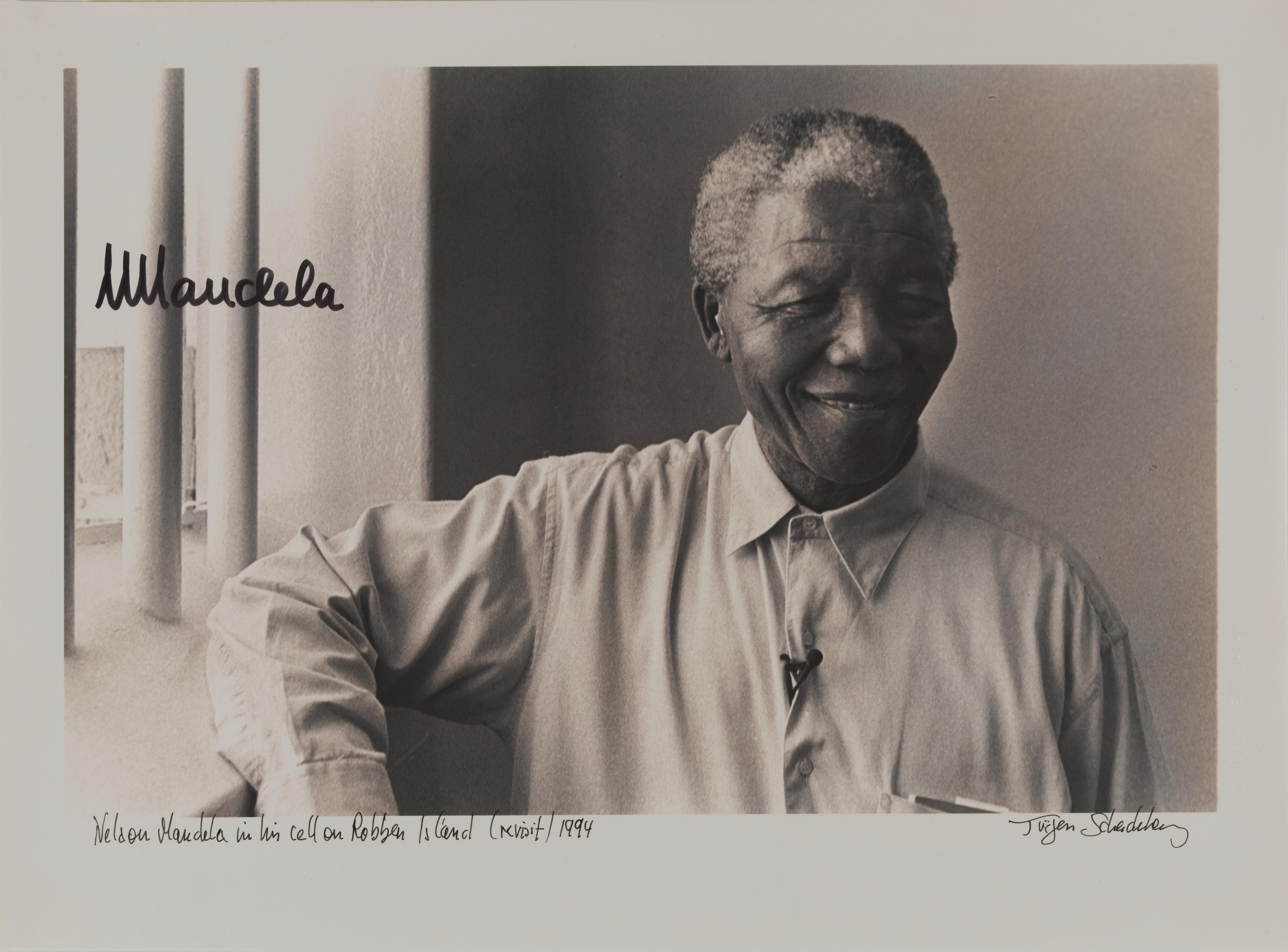Gelatin silver print, printed in 2013 35 x 52 cm (13.8 x 20.5 in) Signed, titled and dated by the photographer in ink in the margin, signed, titled, dated and annotated (print details) by him in ink on the reverse, his copyright stamp on the reverse PROVENANCE directly from the photographer LITERATURE Ralf-P. Seippel (ed.), Jürgen Schadeberg, Ostfildern 2008, p. 16/277. Schadeberg’s portrait of Nelson Mandela taken with a Leica M6, is a late 20th-century photographic icon. It shows the anti-apartheid fighter on February 11, 1994 – two months before he was elected the first black president of South Africa – visiting his former prison cell on Robben Island. Here, in a cell measuring two by two-and-a-half meters, Mandela spent 18 of the 27 years he was imprisoned by the apartheid regime. The photographer remembers the day he took the photograph, exactly four years after Mandela was released from prison: “This was where he studied, did push-ups and reflected on the goal of the liberation of his people. He looked out of the bars and when he thought I had finished taking pictures, relaxed somewhat, and turned around to smile.” Schadeberg first portrayed Mandela in 1952, when he had just arrived in South Africa himself and found a job at the magazine Drum. As the magazine’s chief photographer, the native of Berlin became the chronicler of the pulsating life of the 1950s, in jazz clubs and on the streets of Sophiatown, a focal point of black identity in Johannesburg. He also documented the resistance against apartheid politics. Schadebergs mit einer Leica M6 aufgenommenes Porträt von Nelson Mandela ist eine der fotografischen Ikonen des späten 20. Jahrhunderts. Es zeigt den Anti-Apartheid-Kämpfer am 11. Februar 1994, zwei Monate vor seiner Wahl zum ersten schwarzen Präsidenten Südafrikas, beim Besuch in seiner ehemaligen Gefängniszelle auf Robben Island. Hier, auf einer Fläche von zwei mal zweieinhalb Meter, hatte Mandela 18 der insgesamt 27 Jahre verbracht, die ihn das Apartheid-Regime in Gefangenschaft hielt. Der Fotograf erinnert sich an den Tag der Aufnahme, genau vier Jahre nach Mandelas Entlassung aus der Haft: „Dies war der Ort, an dem er studiert, seine Liegestützen gemacht und über die Befreiung seines Volks nachgedacht hatte. Er sah durch die Gitterstäbe nach draußen und als er glaubte, ich hätte meine Bilder geschossen, entspannte er sich und drehte sich mit einem Lächeln zu mir.“ Schadeberg hatte Mandela erstmals 1952 porträtiert, als er selbst gerade nach Südafrika gekommen war und bei der Illustrierten Drum angeheuert hatte. Als Cheffotograf des Magazins wurde der gebürtige Berliner in den 1950er Jahren zum Chronisten des pulsierenden Lebens in den Jazz-Clubs und auf den Straßen von Sophiatown, einem Kristallisationspunkt schwarzer Identität in Johannesburg, und dokumentierte den Widerstand gegen die Politik der Apartheid.
Gelatin silver print, printed in 2013 35 x 52 cm (13.8 x 20.5 in) Signed, titled and dated by the photographer in ink in the margin, signed, titled, dated and annotated (print details) by him in ink on the reverse, his copyright stamp on the reverse PROVENANCE directly from the photographer LITERATURE Ralf-P. Seippel (ed.), Jürgen Schadeberg, Ostfildern 2008, p. 16/277. Schadeberg’s portrait of Nelson Mandela taken with a Leica M6, is a late 20th-century photographic icon. It shows the anti-apartheid fighter on February 11, 1994 – two months before he was elected the first black president of South Africa – visiting his former prison cell on Robben Island. Here, in a cell measuring two by two-and-a-half meters, Mandela spent 18 of the 27 years he was imprisoned by the apartheid regime. The photographer remembers the day he took the photograph, exactly four years after Mandela was released from prison: “This was where he studied, did push-ups and reflected on the goal of the liberation of his people. He looked out of the bars and when he thought I had finished taking pictures, relaxed somewhat, and turned around to smile.” Schadeberg first portrayed Mandela in 1952, when he had just arrived in South Africa himself and found a job at the magazine Drum. As the magazine’s chief photographer, the native of Berlin became the chronicler of the pulsating life of the 1950s, in jazz clubs and on the streets of Sophiatown, a focal point of black identity in Johannesburg. He also documented the resistance against apartheid politics. Schadebergs mit einer Leica M6 aufgenommenes Porträt von Nelson Mandela ist eine der fotografischen Ikonen des späten 20. Jahrhunderts. Es zeigt den Anti-Apartheid-Kämpfer am 11. Februar 1994, zwei Monate vor seiner Wahl zum ersten schwarzen Präsidenten Südafrikas, beim Besuch in seiner ehemaligen Gefängniszelle auf Robben Island. Hier, auf einer Fläche von zwei mal zweieinhalb Meter, hatte Mandela 18 der insgesamt 27 Jahre verbracht, die ihn das Apartheid-Regime in Gefangenschaft hielt. Der Fotograf erinnert sich an den Tag der Aufnahme, genau vier Jahre nach Mandelas Entlassung aus der Haft: „Dies war der Ort, an dem er studiert, seine Liegestützen gemacht und über die Befreiung seines Volks nachgedacht hatte. Er sah durch die Gitterstäbe nach draußen und als er glaubte, ich hätte meine Bilder geschossen, entspannte er sich und drehte sich mit einem Lächeln zu mir.“ Schadeberg hatte Mandela erstmals 1952 porträtiert, als er selbst gerade nach Südafrika gekommen war und bei der Illustrierten Drum angeheuert hatte. Als Cheffotograf des Magazins wurde der gebürtige Berliner in den 1950er Jahren zum Chronisten des pulsierenden Lebens in den Jazz-Clubs und auf den Straßen von Sophiatown, einem Kristallisationspunkt schwarzer Identität in Johannesburg, und dokumentierte den Widerstand gegen die Politik der Apartheid.














Testen Sie LotSearch und seine Premium-Features 7 Tage - ohne Kosten!
Lassen Sie sich automatisch über neue Objekte in kommenden Auktionen benachrichtigen.
Suchauftrag anlegen